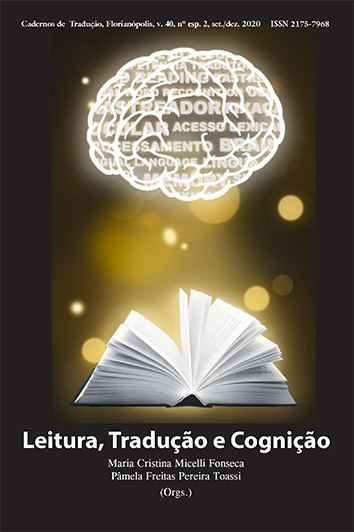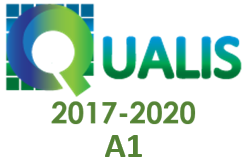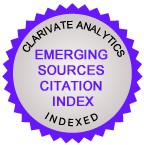The effect of cognate words on lexical access of English as a third language
DOI:
https://doi.org/10.5007/2175-7968.2020v40nesp2p74Abstract
In this paper, the results of an experimental study carried out in order to investigate the effect of triple cognates in the lexical access of speakers of English (L3), German (L2), and Brazilian Portuguese (L1) is presented. Participants performed a reading task, containing 60 experimental sentences with the following critical words: triple cognates, double cognates between Brazilian Portuguese and English, and double cognates between German and English. Participants’ eye movements were recorded while they performed the task. The measures of first fixation and first reading pass times were analyzed. The results suggested that triple cognates were processed faster than their respective controls in first fixation (M: 264/311ms (cognate/control); p=0,03) and first pass (M: 407/448ms (cognate/control); p=0,05), which was interpreted as evidence of a nonselective lexical access and an integrated lexicon for the multilinguals’ languages. In addition, these results contribute to the literature of lexical access of multilinguals, favoring the view that all the languages of a multilingual are active even when the speaker intends to use only one language.
References
Chambers, Craig G.; Cooke, Hilary. “Lexical competition during second-language listening: Sentence context, but not proficiency, constrains interference from the native lexicon”. Journal of Experimental Psychology: Learning, Memory, and Cognition. 35.4, (2009): 1029.
Cop, Uschi; et al. “Reading a book in one or two languages? An eye movement study of cognate facilitation in L1 and L2 reading”. Bilingualism: Language and Cognition. 20.4, (2017): 747-769.
Dijkstra, Ton; et al. “Multilink: a computational model for bilingual word recognition and word translation”. Bilingualism: Language and Cognition. 22.4, (2019): 657-679.
Dijkstra, Ton. “Bilingual visual word recognition and lexical access”. Handbook of bilingualism: Psycholinguistic approaches, Kroll, Judith F. and Annette MB De Groot, (Eds.). Oxford: University Press, 2005, pp. 179-201.
Dijkstra, Ton; Grainger, Jonathan; Heuven, Walter JB Van. “Recognition of cognates and interlingual homographs: The neglected role of phonology”. Journal of Memory and language. 41.4, (1999): 496-518.
Dijkstra, Ton; Heuven, Walter JB Van. “The architecture of the bilingual word recognition system: From identification to decision”. Bilingualism: Language and cognition. 5.3, (2002): 175-197.
Duñabeitia, Jon Andoni; et al. “Electrophysiological correlates of the masked translation priming effect with highly proficient simultaneous bilinguals”. Brain research. 1359, (2010): 142-154.
Hoversten, Liv J.; Traxler, Matthew J. “A time course analysis of interlingual homograph processing: Evidence from eye movements”. Bilingualism: Language and Cognition. 19.2, (2016): 347-360.
Jared, Debra; Kroll, Judith F. “Do bilinguals activate phonological representations in one or both of their languages when naming words?”. Journal of memory and language. 44.1, (2001): 2-31.
Kerkhofs, Roel; et al. “Testing a model for bilingual semantic priming with interlingual homographs: RT and N400 effects”. Brain research. 1068.1, (2006): 170-183.
Kroll, Judith F.; Stewart, Erika. “Category interference in translation and picture naming: Evidence for asymmetric connections between bilingual memory representations”. Journal of memory and language. 33.2, (1994): 149.
Lauro, Justin; Schwartz, Ana I. “Cognate effects on anaphor processing”. Journal of Experimental Psychology: Learning, Memory, and Cognition. 45.3, (2019): 381.
Lemhöfer, Kristin; Dijkstra, Ton. “Recognizing cognates and interlingual homographs: Effects of code similarity in language-specific and generalized lexical decision”. Memory & Cognition. 32.4, (2004): 533-550.
Lemhöfer, Kristin; Dijkstra, Ton; Michel, Marije. “Three languages, one ECHO: Cognate effects in trilingual word recognition”. Language and cognitive processes. 19.5, (2004): 585-611.
Libben, Maya R.; Titone, Debra A. “Bilingual lexical access in context: evidence from eye movements during reading”. Journal of Experimental Psychology: Learning, memory, and cognition. 35.2, (2009): 381.
Marian, Viorica; Spivey, Michael; Hirsch, Joy. “Shared and separate systems in bilingual language processing: Converging evidence from eyetracking and brain imaging”. Brain and language. 86.1, (2003): 70-82.
Perea, Manuel; Dunabeitia, Jon Andoni; Carreiras, Manuel. “Masked associative/semantic priming effects across languages with highly proficient bilinguals”. Journal of Memory and Language. 58.4, (2008): 916-930.
Poarch, Gregory J.; Van Hell, Janet G. “Cross-language activation in children’s speech production: Evidence from second language learners, bilinguals, and trilinguals”. Journal of Experimental Child Psychology. 111.3, (2012): 419-438.
Poort, Eva D.; Rodd, Jennifer M. “Towards a distributed connectionist account of cognates and interlingual homographs: Evidence from semantic relatedness tasks”. PeerJ 7. (2019): 6725.
Rayner, Keith. “Eye movements in reading and information processing: 20 years of research”. Psychological bulletin. 124.3, (1998): 372-422.
Reichle, Erik D. “Serial-attention models of reading”. The Oxford handbook of eye movements, Liversedge, Simon; Iain Gilchrist and Stefan Everling. (Eds.). Oxford: University Press, 2011, pp. 767-786.
Roberts, Leah; Siyanova-Chanturia, Anna. “Using eye-tracking to investigate topics in L2 acquisition and L2 processing”. Studies in Second Language Acquisition. 35.2, (2013): 213-235.
Schwartz, Ana I.; Kroll, Judith F. “Bilingual lexical activation in sentence context”. Journal of memory and language. 55.2, (2006): 197-212.
Sunderman, Gretchen; Kroll, Judith F. “First language activation during second language lexical processing: An investigation of lexical form, meaning, and grammatical class”. Studies in second language acquisition. 28.3, (2006): 387-422.
Szubko-Sitarek, Weronika. Multilingual lexical recognition in the mental lexicon of third language users. Heidelberg: Springer, 2015.
Telstad, Siri. Investigating potential L3 cognate facilitation effects on L2-A study of Spanish-English cognates in L1 speakers of Norwegian. MS thesis. NTNU, 2018.
Titone, Debra; et al. “Bilingual lexical access during L1 sentence reading: The effects of L2 knowledge, semantic constraint, and L1–L2 intermixing”. Journal of Experimental Psychology: Learning, Memory, and Cognition. 37.6, (2011): 1412.
Van Assche, Eva; Duyck, Wouter; Brysbaert, Marc. “Verb processing by bilinguals in sentence contexts: The effect of cognate status and verb tense”. Studies in Second Language Acquisition. 35.2, (2013): 237-259.
Vanlangendonck, Flora; et al. “Mixing the stimulus list in bilingual lexical decision turns cognate facilitation effects into mirrored inhibition effects”. Bilingualism: Language and Cognition. (2020): 1-9.
Yip, Michael CW; Zhai, Mingjun. “Processing Homophones Interactively: Evidence from eye-movement data”. Scientific reports. 8.1, (2018): 1-11.
Yudes, Carolina; Macizo, Pedro; Bajo, Teresa. “Cognate effects in bilingual language comprehension tasks”. NeuroReport. 21.7, (2010): 507-512.
Zhu, Yanjiao; Mok, Peggy Pik Ki. “Visual recognition of cognates and interlingual homographs in two non-native languages: Evidence from Asian adult trilinguals”. Linguistic Approaches to Bilingualism. (2019).
Downloads
Published
How to Cite
Issue
Section
License
Copyright (c) 2020 Cadernos de Tradução

This work is licensed under a Creative Commons Attribution 4.0 International License.
Copyright Notice
Authors hold the copyright and grant the journal the right for their articles' first publication, being their works simultaneously licensed under the Creative Commons Attribution License (CC BY), which allows the sharing of such works with its authorship acknowledged and its initial publication in this journal.
Authors are allowed to enter into separate additional contractual arrangements for the non-exclusive distribution of the journal's published version of the work (e.g., post it to an institutional repository or as a book chapter, with an acknowledgment of its initial publication in this journal).






















































